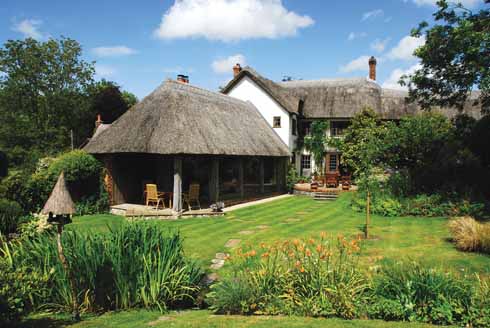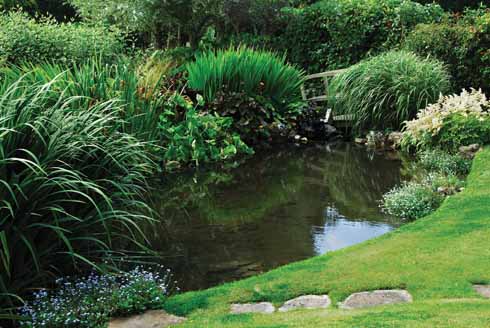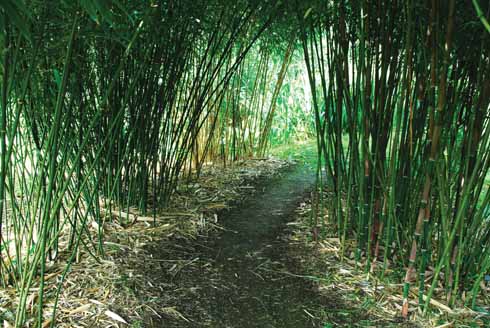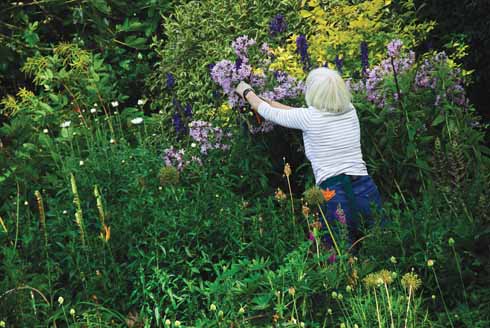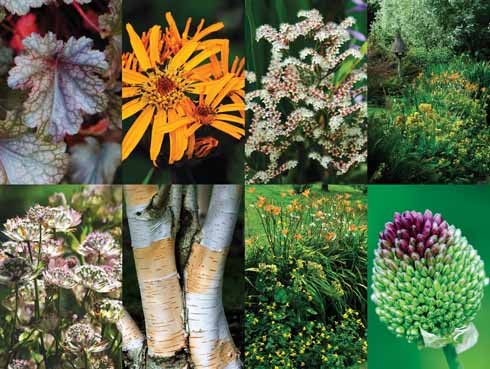Gardens: The Old Smithy, Ibberton
Chris Shaw and Colin Varndell visit a garden that has been twelve years in the making
Published in September ’12
On our visit to the Old Smithy, it didn’t just rain, it poured; water came down in sheets from a leaden sky, blotting out Bulbarrow and sending visitors scurrying for shelter beneath a convenient thatched overhang. The rain turned the stream ahead into a small sea, ripples spreading out across a widened pond to form wavelets lapping against its edges. The stream rises just below the village church of St Eustace and flows constantly whatever the weather. Clive and Carol Carsley have used it very cleverly in their 2½ acre garden, planting sympathetically along its banks in an understated way that is totally in keeping with their rural location. Three further ponds are fed from the stream, water forming a major element of the overall garden design. The immediate impression is of a landscape that has been gently moulded into place; there are no harsh boundaries or formal schemes. Hard work, certainly, but by enhancing natural features the couple have created a garden that is a peaceful, beautiful frame for the Old Smithy itself.
Clive and Carol bought the property in 2000 when it was in a sorry state of repair. There was virtually no garden, except a few shrubs and vegetables. Rebuilding the house was coupled with damming the stream and moving soil to create a level lawn. The excess soil was used to build a very effective sloping semi-circular bed which is now packed with shrubs and perennials. The slope of the bed means that everything can be seen much more clearly than in a level bed of the same width. It is backed by a high privet hedge which provides shelter and seclusion and which also makes a good dark green backdrop for delphiniums, astrantias, phlox, acanthus and a collection of alliums. Dashes of cream and yellow are provided by variegated weigela and golden cornus. Tucked in at the front of the bed are heucheras and alchemilla. The hellebores had finished flowering but their large and handsome leaves were filling in well as the later perennials were beginning to strut their stuff.
The semi-circular terrace behind the house must be a lovely place to sit and enjoy the view, with a fig tree nearby; a Magnolia grandiflora and wisteria cover the house walls. Just a couple of pots of bright pink pelargoniums add that extra ‘zing’. An old grinding wheel rescued from the smithy now makes an unusual feature, positioned on the lawn in a sea of waving grasses. Just a few paces down from the terrace is the stream edged with iris and grasses, plumy white astilbe, tall white daisies and the mahogany foliage of rogersia. A magnificent clump of candelabra primulas is doing interesting things, where yellow and orange plants have merged in an unusual dual-colour combination.
A wide jump away across the stream the land rises to a small mown plateau. Beyond, the meadow is left mainly long but with broad mown paths which encourage you to wander. There are trees everywhere, planted in clumps to good effect, and triple wigwams of sweet-peas with tall rustic supports. An arched bridge is an easier way to reach the other side of the stream, with roses overhanging the wall picking up the colour of a pink-flowering sambucus. One can then stroll on through peaceful, secluded green, the sound of water ever-present.
The first large pond is edged with Iris pseudocurus and Iris laevigata. Clumps of ranunculus and hosta spread lower on the banks. Water hawthorn floats elegantly on the surface, while massed tall grasses create a wonderful jungle feel. The far side of the pond is enclosed by generous clumps of Cornus alba and Cornus alba ‘Sibirica’, both grown for their scarlet winter stems. There is a wine-coloured day lily, for just a dash of summer colour, but much of this garden proves that bright colours are not always necessary for impact.
Nearby, a small copse of willows drapes fine foliage above the giant leaves of butterbur. This plant has the largest leaves of any native British plant. They were once used for wrapping butter – hence the name – and the plant has the bonus of being very attractive to bees. It is dwarfed only by the gigantic gunnera just a little further on. The broad-leaved butterbur is edged by clumps of decorative grass; a contrast that works well. I loved the small ducks waddling close to the edge of the path. Sculptures don’t have to be obvious.
The three ponds on this side of the bridge are all dug into clay soil which was used as an effective and natural liner. They are fed by a pipe from the stream which takes advantage of the falling ground in what used to be a boggy and unattractive area but is now a highlight of the garden. The water features culminate in a final pond where phragmites, the common reed, is used to treat a septic tank outflow carefully piped to it beneath the ponds. The outflow is then safe to rejoin the stream beyond a pretty willow arbour; a clever and ecologically sound solution to a common problem in rural Dorset.
The water garden culminates in a bamboo tunnel forming a T-junction, where elegant stems towered way above my head and gave me a choice of direction. Beeches, birches, rowans, fruit trees, flowering cherries, all are planted several of each. A garden this size takes some filling. It is also enclosed by mature trees, a sea of different greens. The coffin path, an ancient route to the church, runs along the boundary behind a line of magnificent oak trees. A tree house is tucked in amongst them: a grandchild’s delight.
Strolling back towards the house beneath a sky now brilliant blue and giving no hint of the earlier deluge, I could hardly see the Old Smithy it is so well tucked into its surroundings. On a nearby hillside, St Eustace’s Church looks down on Ibberton like a medieval folly.
Beyond a hedge and over a stile I found the vegetable garden with attendant scarecrow. Strawberries, rhubarb and soft fruit bushes were in neat ranks with potatoes, beans and onions. There is an easier access, too, leading back to the streamside and the main back garden. In a yard edged by staddle stones and a stone sink of bright flowers, there was a plant stall in full swing – always a good opportunity to add something at modest cost to one’s own garden – to serve as an ongoing reminder of the visit.
If you are a book lover, a visit to the Old Smithy has an added dimension. Carol and Clive are proud that their daughter Natasha Solomon’s best-seller Mr Rosenblum’s List was inspired by the area and the family’s involvement with it over the years. Now that’s what I call a really enjoyable afternoon: a beautiful garden and a good book.
The Old Smithy was open to all under the National Gardens Scheme, but also by appointment at other times to parties of twenty or fewer (01258-817361). Opening one year does not guarantee opening the next, so do check the Yellow Book for details and respect garden owners’ privacy if they are ‘resting’.
Water, water everywhere
There is nothing quite like water in a garden. Natural ponds, such as those at the Old Smithy, will bring wildlife into the garden as well as affording the opportunity to grow a very different collection of plants. Choose an open location, away from trees and on level ground. Mark out the shape using a hosepipe or piece of rope, viewing it from all angles until you get it just right. A minimum of 4-5 square metres surface area will encourage frogs and newts to breed as well as attracting some dragonfly species. Keep it shallower at the edges, to make it accessible, with a deeper basin of 60-75cms to prevent the water from freezing and protect hibernating wildlife.
At the Old Smithy, clay was worked into a natural pond liner. There are many readily-available flexible liners and savings can be made by cushioning it on old carpet rather than importing a good layer of sand.
When you’re ready to fill the pond, you just can’t beat rainwater. Tap water has high levels of nutrients, which encourage algae. If there is no other alternative, let the filled pond stand for as long as possible before starting to plant.
Once you’re ready to plant, the choice is wide. Long grasses nearby will provide good cover for amphibians. An ideal pond mix includes oxygenating plants such as water starwort, to keep the water clear; floating plants, such as water lilies and water hyacinth. Marsh marigold and yellow flag are good native emergents. Marginal plants are ornamental and do not necessarily help conserve the balance of the pond. Ligularia, astilbe, candelabra primulas, crocosmia – there are many more. Head for the library or the internet and read up the finer detail. You might never dig that pond but, like all potential gardening projects, you’ll have great fun planning it.
